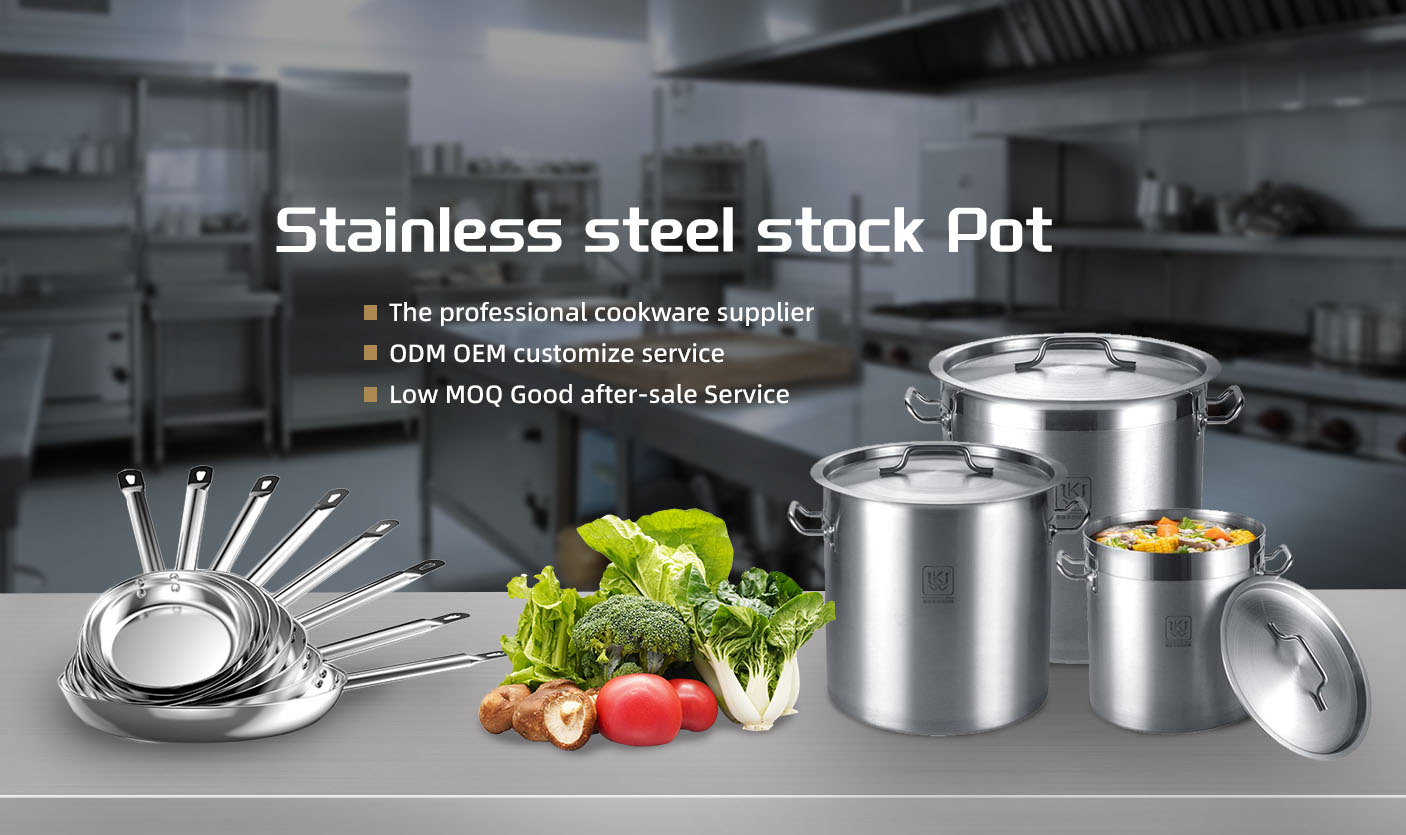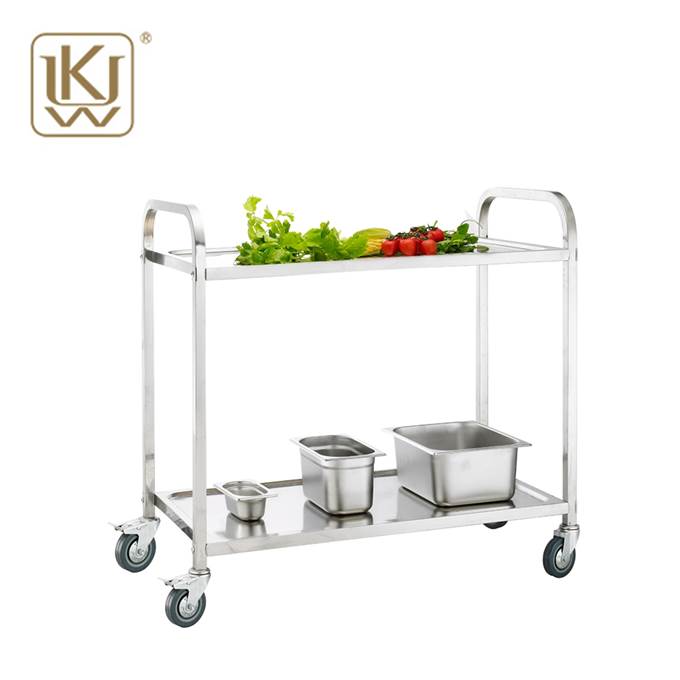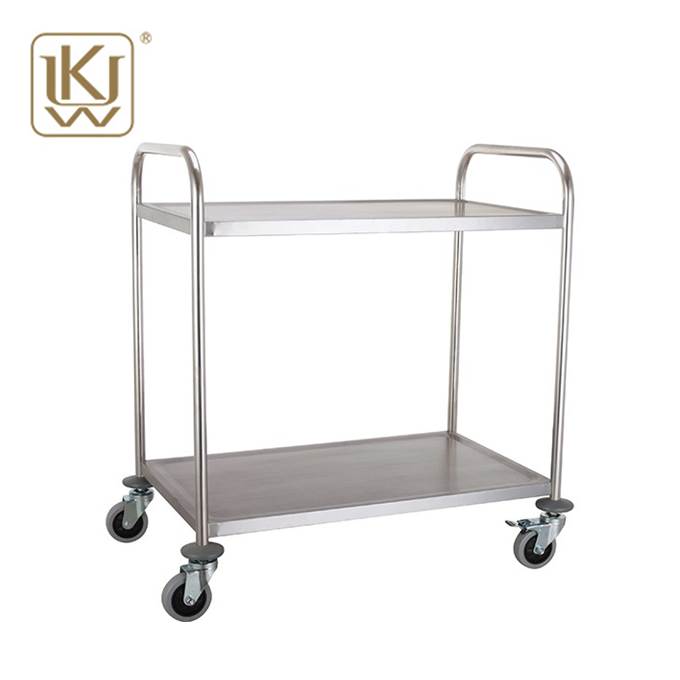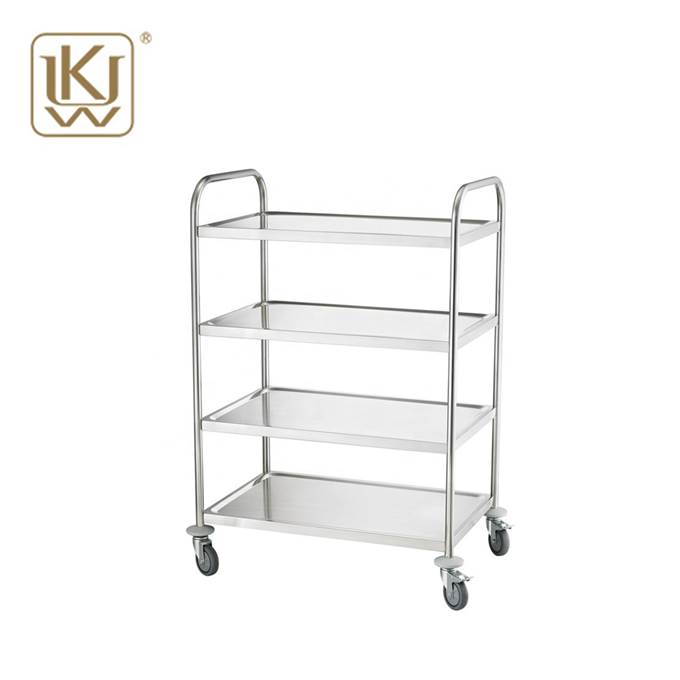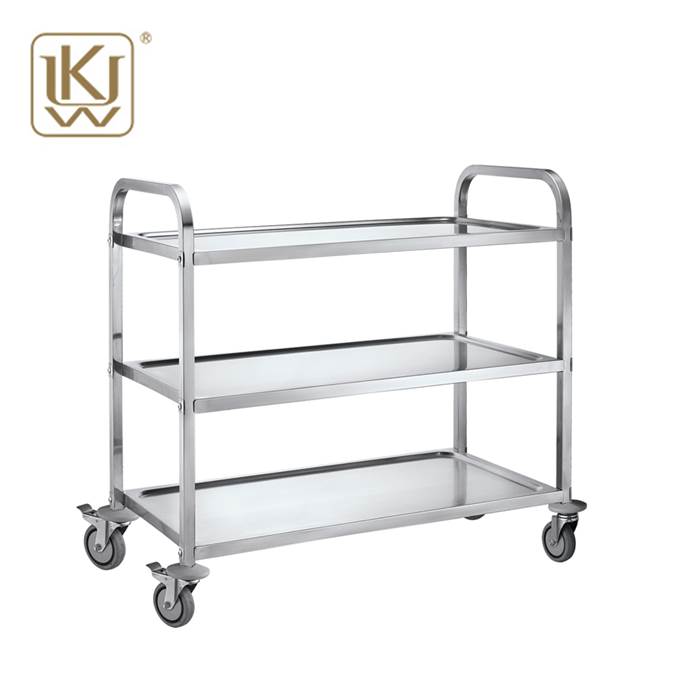Three Layers Stainless Steel Serving Cart
- Product Information
Stainless Steel Serving Cart is a stainless steel trolley designed for transporting and displaying items. It usually has multiple layers of flat stainless steel shelves for placing various items such as tableware, food, cleaning supplies, etc. The trolley is equipped with easy-to-push handles and wheels, allowing it to be flexibly moved between different venues.
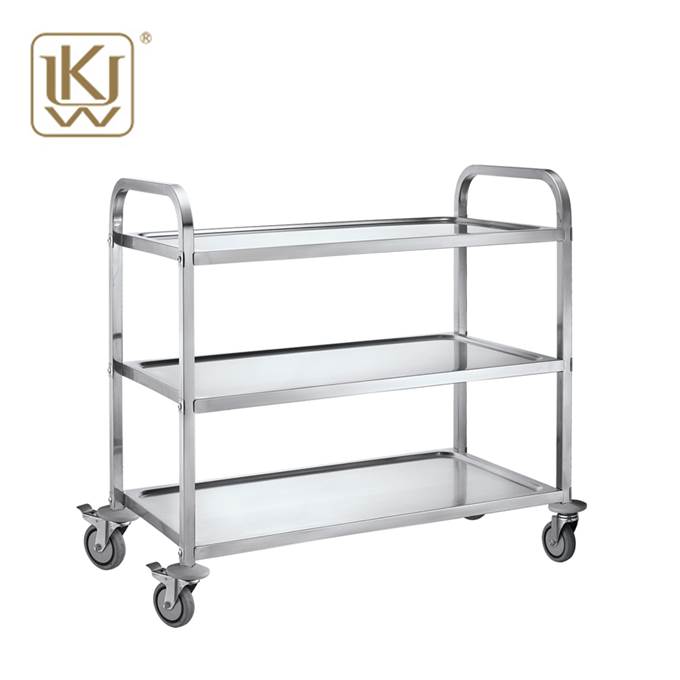
Stainless Steel Serving Cart Parameters:
| CODE | Dimension(mm) | Factory Nature |
| PRD-L3 | 950*500*950 | China Suppliers Manufacturers Exporter |
| PRD-M3 | 850*450*900 | China Suppliers Manufacturers Exporter |
| PRD-S3 | 750*400*835 | China Suppliers Manufacturers Exporter |
Stainless Steel Serving Cart Features:
Stainless steel material
Strong corrosion resistance: can resist the erosion of various chemicals, not easy to rust, can be used in humid or detergent environments.
High strength: can bear the weight of heavier items, not easy to deform, and ensure the stable placement of items.
Easy to clean: the surface is smooth, stains are not easy to adhere, and it can be restored to cleanliness by wiping with a damp cloth.
Beautiful: with metallic luster, it improves the overall grade of the place of use.
Anti-oxidation: long-term use will not cause oxidation and discoloration, and keep the appearance as new.
High temperature resistance: can be used normally within a certain temperature range, and will not be damaged by thermal expansion and contraction.
3-layer design
Sufficient capacity: the three-layer structure can hold more items and meet most of the handling and display needs.
Reasonable stratification: the spacing between each layer is moderate, and the placement method can be flexibly adjusted according to the size of the item.
No interference: each layer is independent, the items are clearly classified, easy to take, and avoid confusion.
Good stability: the weight distribution of the three layers is even, and the cart is not easy to overturn.
High space utilization: make full use of vertical space, saving more ground space than single-layer carts.
Strong expandability: Items with different functions can be placed on each layer as needed to achieve diversified use.
Cart form
Easy to move: equipped with wheels, it can be easily pushed to adapt to the transportation of items between different venues.
Simple operation: Only one person is needed to complete the pushing and turning operations without complicated skills.
High flexibility: It can pass flexibly through narrow passages and turns and adapt to a variety of environments.
Save time and effort: Carry a large number of items at one time, reduce the number of round trips, and improve work efficiency.
Good safety: The wheels are equipped with brakes, which can be fixed at any time to prevent accidental sliding.
Wide applicability: It can travel stably whether it is flat or slightly undulating.
Stainless Steel Serving Cart Application:
Restaurant
Restaurant kitchen: used to carry ingredients, tableware, kitchen utensils, etc., to facilitate chefs to use and improve meal preparation efficiency.
Restaurant front desk: as a food delivery vehicle, it delivers dishes from the kitchen to the customer's table quickly and stably to maintain the temperature and integrity of the dishes.
Restaurant cleaning area: used to collect and carry tableware residues, cleaning supplies, etc., to maintain the sanitary environment of the restaurant.
Hotel
Room service: deliver meals, towels, toiletries, etc. to the guest rooms, so that the waiter can efficiently complete the room tidying and item replenishment.
Hotel restaurant: similar to ordinary restaurants, used for meal preparation, food delivery and other links to meet the hotel's catering service needs.
Hotel conference area: carry tea breaks, documents and other items required for meetings to ensure the smooth progress of meetings.
Hospital
Ward nursing: nurses can push it to carry medicines, medical equipment, etc., to facilitate ward rounds and treatment.
Hospital cafeteria: used for food transportation between kitchens and wards and departments to ensure that patients and medical staff can eat in time.
Hospital cleaning department: collect and carry medical waste, cleaning tools, etc. to keep the hospital environment clean.
School
School canteen: used for food processing, tableware distribution, food transportation, etc., to ensure school catering supply.
Classroom: teachers can use it to carry teaching supplies, experimental equipment, etc. to facilitate teaching activities.
Student dormitory: dormitory management staff use it to carry dormitory maintenance tools, daily necessities, etc. to improve dormitory management efficiency.
Factory
Production workshop: carry raw materials, semi-finished products, finished products, etc., to realize the flow of materials between different processes.
Factory warehouse: used for short-distance transportation and inventory of goods to improve warehouse management efficiency.
Factory cleaning area: collect and carry production waste, cleaning supplies, etc. to keep the factory clean.
Stainless Steel Serving Cart Maintenance:
Daily cleaning
Cleaning after use: After each use, wipe the surface of the cart with a clean damp cloth, focusing on removing dust, stains and residual debris, and ensure that there are no obvious stains on the surface of the cart.
Mild detergent: When encountering stubborn stains, use a mild detergent to clean, and avoid using strong acid and alkali detergents to prevent corrosion or damage to the stainless steel surface.
Shelf cleaning: Regularly check and clean the shelves of the cart, especially pay attention to removing stagnant water or food residues to prevent bacteria from growing due to a humid environment or signs of rust on the stainless steel shelves.
Dry the cart: After cleaning, carefully wipe the surface of the cart with a dry cloth to avoid residual moisture, prevent water stains on the stainless steel surface or oxidation reactions due to long-term moisture.
Detail cleaning: During the cleaning process, pay special attention to the wheels and handles of the cart, clean the dust and debris in the gaps, and ensure that the flexibility and aesthetics of these parts are not affected.
Surface inspection: When wiping the cart, check the surface for scratches. For minor scratches, use a special stainless steel polish to treat it in time to restore the surface gloss.
Regular inspection
Wheel inspection: Check the rotation of the cart wheels every week to ensure that it is smooth and without jamming. If there is any abnormality, add lubricating oil in time to ensure the flexibility and durability of the wheels.
Brake test: Regularly test whether the wheel brake device is sensitive and effective. If the brake fails or responds slowly, repair or replace the relevant parts immediately to ensure safe use.
Tightening of connection parts: Check the firmness of each connection part of the cart. If the screws are loose, tighten them in time to prevent the cart from shaking or parts falling off during use due to unstable connection.
Handle inspection: Check whether the cart handle is deformed, damaged or worn on the surface to ensure the structural integrity and comfort of the handle. If there is any problem, repair or replace it in time.
Shelf inspection: Regularly check whether the cart shelf has deformation, dents or cracks in the welding parts. If found, take measures such as adjusting or replacing the shelf in time to ensure the cart's carrying capacity and stability.
Overall structure inspection: Conduct a comprehensive inspection of the overall structure of the cart to check whether there are potential problems such as rust and weld detachment, and deal with them in time to avoid the problem from expanding and affecting the service life of the cart.


